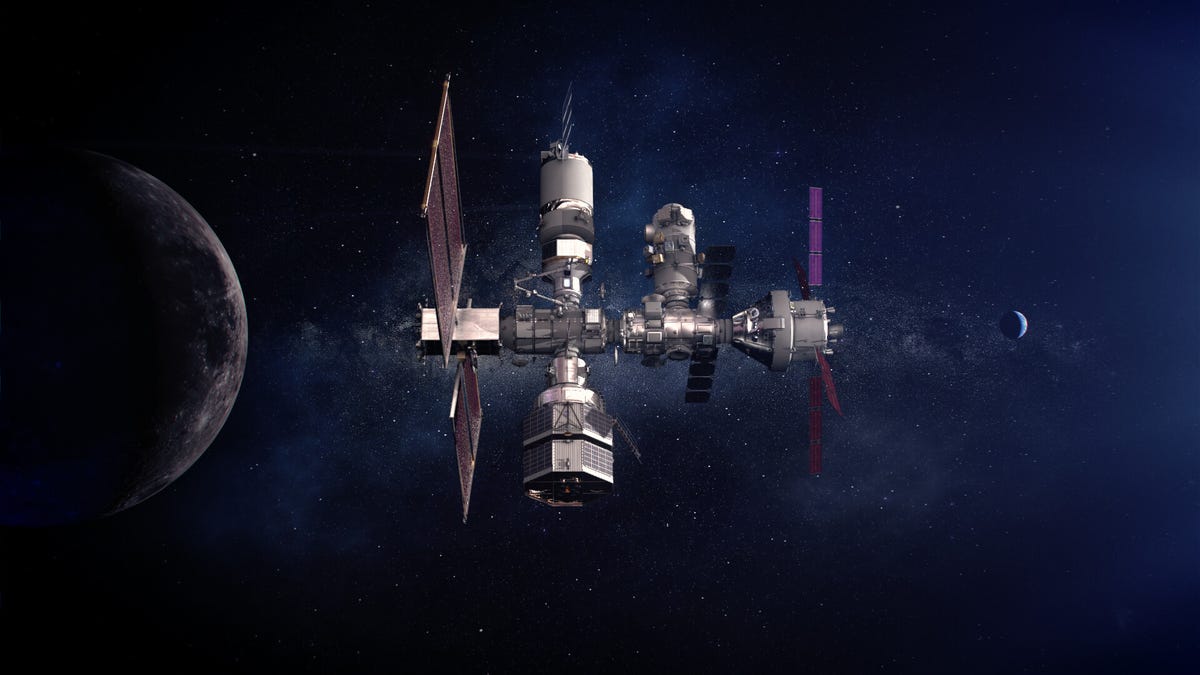[ad_1]

NASA, along with a suite of international and private partners, has big plans to build a small space station. Called Lunar Gateway, the proposed outpost will support missions at and around the Moon and provide a unique platform for conducting science. Here’s what you should know about the upcoming space station and how it’ll enable the next giant leap in space exploration.
We’ve sent humans to the lunar surface, built space stations in low Earth orbit, landed rovers on Mars, and even sent spacecraft on journeys to the outer reaches of the solar system. Impressive, no doubt, but plenty of items remain on the celestial to-do list, not least of which is the construction of a station around the Moon. That we have yet to do so seems like a glaring omission, but this is where we find ourselves today.
Why do we need a lunar space station?
The upcoming Artemis era has given NASA an excuse for finally building such a thing. Well, excuse is probably not the right word; the construction of a lunar space station is more of a necessity, given NASA’s stated goal of building a sustained human presence at and around the Moon. The space agency is seeking to land a man and woman on the lunar surface no earlier than 2025, but this, the Artemis 3 mission, represents the tip of the iceberg.
Plans are in the works for an Artemis base camp that would consist of a surface habitat, a pressurized rover, and an agile lunar terrain vehicle. The ensuing infrastructure will further enable our exploration of the Moon, but the experience and technology gained during these missions are meant to enable the next giant leap for humankind: a crewed mission to Mars. None of this will be possible, however, without a lunar space station.

G/O Media may get a commission
As NASA explained in a 2018 memorandum, Lunar Gateway “is central to advancing and sustaining human space exploration goals, and is the unifying single stepping off point in our architecture for human cislunar operations [cislunar refers to the region between Earth and Moon], lunar surface access and missions to Mars.” Once in lunar orbit, the multi-purpose Gateway, at one-sixth the size of the International Space Station, would provide support for crewed missions to the surface, a platform for performing science, and a staging point for deploying missions deeper into space, including robotic probes for studying nearby asteroids and comets.
Where will Lunar Gateway be located?
The current plan is to place Gateway in a near-rectilinear halo orbit, or NRHO. This fuel-efficient orbit takes advantage of neutral gravity points generated by the Earth and the Moon. In addition to being gravitationally stable, NRHO will provide the orbital outpost with a continuous line of sight to Earth, allowing for unobstructed communication between Gateway’s crew and ground stations back home.

NRHO is highly elliptical, so the space station will come to within approximately 1,865 miles (3,000 kilometers) of the Moon during its closest approach but then travel out to a distance of 43,500 miles (70,000 km) before heading back in again, according to the European Space Agency. A full orbit should take about a week.
The CAPSTONE probe is currently en route to the Moon, having launched on June 28. The smallsat will enter into NRHO on November 13, becoming the first human-built object to do so. CAPSTONE will test the suitability of this halo orbit for Gateway, in addition to testing a new spacecraft-to-spacecraft communications capability.
How will Lunar Gateway be built?
NASA and SpaceX have powerful rockets, but nothing exists to launch a fully (or even partially) constructed space station. Accordingly, and like any space station, it’ll have to be built in space across a series of phases.
The first components could reach lunar orbit as early as 2024, setting the stage for Artemis 3—the first crewed mission to the Moon since Apollo 17 in December 1972 (that said, Artemis 3 is not dependent on Gateway, as NASA’s Orion spacecraft could dock with the Human Landing System, which is currently slated to be SpaceX’s Starship). The station will be further assembled in the vicinity of the Moon and perform slight orbital adjustments to accommodate specific missions. NASA is partnering with both international and private partners to make Gateway possible, and has allocated $779 million of its 2023 budget for the project.

The first phase will see the union of two critically important elements: a module to provide power and propulsion and a module to support human activities. For Gateway, these components are referred to as the Power and Propulsion Element (PPE) and the Habitation and Logistics Outpost (HALO). NASA is hoping to launch the PPE and HALO together during a single launch of a SpaceX Falcon Heavy rocket no earlier than May 2024, at a cost of $331.8 million. Future launches will support Gateway, whether to add new components or deliver cargo.
How big is Lunar Gateway?
The first five elements will consist of the PPE, HALO, a communications and connecting module, a science and airlock module, a logistics module (for holding food and supplies), and a robotic arm. Combined, these elements will weigh 40 metric tons. It’ll be a humble start, but these core components will serve as the foundation upon which a larger station will be built over time.

The European Space Agency (ESA) says Gateway will support four astronauts for 90-day stays. The single HALO module won’t provide adequate space for astronauts, requiring an additional habitable module that’ll be built by ESA. Once locked together, the two modules will provide 4,414 cubic feet (125 cubic meters) of space, a volume roughly the size of a double decker bus.
What are the components of the lunar space station?
PPE will be a 50-kilowatt solar electric propulsion spacecraft capable of providing power, high-speed communications, and maneuvering capabilities, such as attitude control and orbital transfers. In 2019, Maxar Technologies of Colorado signed a $375 million non-fixed contract with NASA to develop and build the PPE. The module will use solar panels to generate the electrical energy required to power the outpost.

NASA tapped Northrop Grumman to build HALO, a habitable, pressurized module. The Virginia-based company finalized a $935 million fixed-price contract with the space agency in July 2021. HALO is being modeled after the pre-existing Northrop Grumman’s Cygnus cargo transportation vehicle. HALO will have the same diameter as Cygnus, but at 20 feet (6.1 meters) in length, it’ll be about 3 feet (1 meter) longer to accommodate crews.
HALO will provide a place for astronauts to live, work, research, and sleep. It’s where crews will perform their science experiments, dispatch ground crews to the surface, and communicate with ground stations on Earth. The habitable module is where the command and control station will exist, and will also host docking ports for supporting the arrival and departure of crewed spacecraft (notably Orion), lunar landers, and resupply missions. Basic life-support will include the recycling of oxygen and production of drinking water. Naturally, HALO will allow for the connection of additional habitats, as the plan is to expand Gateway in the coming years and (hopefully) decades.

The Japan Aerospace Exploration Agency (JAXA) is providing the batteries needed to power HALO prior to the deployment of the PPE’s solar arrays and during eclipses. Canadarm3 will be the Canadian Space Agency’s contribution to Gateway. The smart robotic system will consist of a 28-foot-long (8.5-meter) arm, a smaller, more nimble arm, and a suite of detachable tools.

ESA is providing the high-data-rate communications capability that will link the orbital base with teams working on the surface. Called ESPRIT (European System Providing Refueling, Infrastructure and Telecommunications), the module will also provide additional fuel and an airlock for science payloads. ESPRIT will feature a window similar to the Cupola observatory on the International Space Station.
ESA and JAXA are also responsible for a second habitable module, known as I-Hab, or International Habitation module. That module will provide further space for the crew to live, work, and perform science. This module is being built by Thales Alenia Space, and it could reach Gateway in 2026 as part of the Artemis 4 mission.
How can we support a space station so far away?
At an average distance of 239,200 miles (385,000 km), the Moon isn’t exactly close. Logistics will be key to supporting astronauts on their missions—a matter not lost on the Gateway partners. What’s more, the experience of providing a supply chain to deep space could inform future missions to Mars.

In 2020, NASA announced SpaceX as the first U.S. commercial provider to be awarded a Gateway Logistics Services contract, under which the Elon Musk-led company will deliver cargo and other supplies to the lunar space station.
SpaceX will need to transport both pressurized and unpressurized cargo to the outpost. NASA estimates that one delivery will be required for each crewed Artemis mission. To do so, SpaceX will launch its Dragon XL spacecraft atop Falcon Heavy rockets. Dragon XLs will be larger versions of Dragon and stay docked to Gateway for six to 12 months at a time. A single Dragon XL will be capable of delivering more than 5 metric tons of cargo, according to SpaceX.
JAXA is also looking to get in on the logistical support. The space agency is currently looking into enhancements that could make its HTV-X cargo spacecraft suitable for Gateway resupply missions. Interestingly, SpaceX’s upcoming Starship rocket could conceivably be used for logistics purposes as well.
What kind of science will be done on board Gateway?
Lots. Lunar and planetary science is the most obvious, but Gateway’s vantage point will also allow for Earth science, heliophysics, and astrophysics. As NASA says, “fundamental physics investigations” will be made possible by virtue of “extended views of the Earth, Sun, Moon, and space not possible from Earth’s surface or from Earth orbit.”
The Gateway partners have already chosen three science instruments. NASA’s HERMES (Heliophysics Environmental and Radiation Measurement Experiment Suite) and ESA’s ERSA (European Radiation Sensors Array) will reside outside the station and monitor the Sun’s radiation and space weather. The third instrument, IDA (Internal Dosimeter Array), is being developed by ESA and JAXA, and it’ll “allow for the study of radiation shielding effects and improve radiation physics models for cancer, cardiovascular, and central nervous system effects, helping assess crew risk on exploration missions,” according to NASA.
Will Gateway missions be dangerous for astronauts?
Like any mission to space, there will be an element of danger. Gateway’s location beyond low Earth orbit and Earth’s magnetosphere means crews are more susceptible to harmful solar and cosmic radiation than astronauts on board the ISS.
“Leaving the protection that Low Earth Orbit provides will unavoidably expose astronauts to higher cumulative doses of space radiation, in addition to other stressors,” such as microgravity, according to a 2021 study published in the International Journal of Molecular Sciences. “Immune regulation is known to be impacted by both radiation and spaceflight and it remains to be seen whether prolonged effects that will be encountered in deep space can have an adverse impact on health.” The expected radiation outside of low Earth orbit is likely to harm the mitochondria of cells and also produce long-term effects on DNA repair, according to the study. And as NASA writes:
Radiation impacts on the human body will be much greater on missions to the Moon or Mars, where exposure to high-energy, charged particles can cause adverse health effects including increased risk of cancers, changes in motor functions and behavior, and degeneration of tissue. Additional risks include potential damage to astronauts’ vehicles and equipment that they rely on to live and travel safely through space.
In all fairness, however, we don’t know the full extent to which astronauts will be affected by space during prolonged stays on Gateway. The Apollo missions likewise exposed astronauts to space radiation, but these missions didn’t last longer than 11 days. Long-duration Gateway missions could last for upwards of 90 days—a length of time that’s more likely to induce long-term health effects. Accordingly, scientists will want to keep a close watch on returning Gateway crews to assess potential harm. That research will then inform future efforts to minimize any detrimental effects.
What will Lunar Gateway be like in the coming decades?
NASA’s intention is to reach the Moon and stay there. That will require a fully robust and functional lunar space station, so we should expect to see Gateway expand over time. Excitingly, Gateway could also serve as the staging point for NASA’s proposed Deep Space Transport, from which a mission to Mars could be launched. Gateway could also be used to track threatening near-Earth objects.
The potential is huge, and only time will tell how we best use Gateway to serve our needs and expand our reach into the solar system—and potentially beyond.



